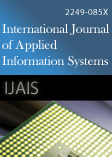
- Hossein Momeni and Homayoun Motameni and Mahtab Larimi 2014. A Neuro-Fuzzy based Approach to Software Quality Requirements Prioritization. International Journal of Applied Information Systems. 7, 7 (August 2014), 15-20. DOI=http://dx.doi.org/10.5120/ijais451207
-
@article{10.5120/ijais2017451568, author = {Hossein Momeni and Homayoun Motameni and Mahtab Larimi}, title = {A Neuro-Fuzzy based Approach to Software Quality Requirements Prioritization}, journal = {International Journal of Applied Information Systems}, issue_date = {August 2014}, volume = {7}, number = {}, month = {August}, year = {2014}, issn = {}, pages = {15-20}, numpages = {}, url = {/archives/volume7/number7/667-1207}, doi = { 10.5120/ijais14-451207}, publisher = { xA9 2013 by IJAIS Journal}, address = {} } -
%1 451207 %A Hossein Momeni %A Homayoun Motameni %A Mahtab Larimi %T A Neuro-Fuzzy based Approach to Software Quality Requirements Prioritization %J International Journal of Applied Information Systems %@ %V 7 %N %P 15-20 %D 2014 %I xA9 2013 by IJAIS Journal
Abstract
Requirements engineering is one of the important topics in software engineering and correct understanding of requirements can affect the total quality of the whole software system. Lack of considering or wrong identification of requirements not only leads to customers' dissatisfaction, but also leads to the software failure and increases the costs of development. Requirement prioritizing plays an important role in decision making process in subsequent phases and eliminates the complexities resulting from vague requirements. The aim is to find the right order of main requirements. Neuro-fuzzy system combines the ability of human reasoning (logic) through predetermined laws with the learning ability of neural networks and can apply the human expertise to find the total output value by using a set of laws stored in knowledge base. In this paper, we propose an effective approach to prioritizing software quality requirements based on neuro-fuzzy system. This paper shows that our proposed approach is more efficient in terms of both the time consumption and the learning ability compared to related approach.
References
- Svensson, R. B. , T. Gorschek, et al. 2011. Prioritization of Quality Requirements: State of practice in eleven companies. 19th IEEE International Conference on Requirements Engineering.
- Babar, M. I. , M. Ramzan, et al. 2011. Challenges and Future Trends in Software Requirements Prioritization. IEEE International Conference on Computer Networks and Information Technology (ICCNIT).
- Wiegers, K. 1999. First Things First: Prioritizing Requirements. Software Development Vol. 7 No. 9, pp. 11-19.
- Berander, P. and A. Andrews 2005. Requirements Prioritization. Engineering and Managing Software Requirements, Springer, pp. 69-94.
- Svensson, R. B. , M. Host, et al. 2010. Managing Quality Requirements: A systematic review. 36th IEEE EUROMICRO Conference on Software Engineering and Advanced Applications.
- Johansson, E. , A. WesslxE9n, et al. 2001. The Importance of Quality Requirements in Software Platform Development: A Survey. 34th IEEE Annual Hawaii International Conference on System Sciences.
- Lehtola, L. , M. Kauppinen, et al. 2004. Requirements Prioritization Challenges in Practice. Product Focused Software Process Improvement, Springer, pp. 497-508.
- Zadeh, L. A. 1965. Fuzzy Sets. Information and Control, Vol. 8 No. 3, pp. 338-353.
- Rajasekaran, S. and G. V. Pai 2003. Neural Networks, Fuzzy Logic and Genetic Algorithm. Synthesis and Application. PHI Learning Pvt. Ltd.
- MartxEDnez Carod, N. and A. Cechich 2005. Classifying Software Requirement Prioritization Approaches. XI Congreso Argentino de Ciencias de la ComputacixF3n.
- Chan, K. Y. , C. Kwong, et al. 2012. Determination of Importance of Customer Requirements Using the Fuzzy AHP Method. Computational Intelligence Techniques for New Product Design, Springer, pp. 59-77.
- Chan, L. -K. and M. -L. Wu 2002. Quality Function Deployment: a Literature Review. European Journal of Operational Research, Vol. 143, No. 3 pp. 463-497.
- Lubars, M. , C. Potts, et al. 1993. A Review of the State of the Practice in Requirements Modeling. IEEE International Symposium on Requirements Engineering.
- Ramzan, M. , M. A. Jaffar, et al. 2010. Value based Intelligent Requirement Prioritization (VIRP): Expert Driven Fuzzy Logic based Prioritization Technique. International Journal of Innovative Computing, Information and Control (IJICIC).
- Kahraman, C. 2008. Fuzzy Multi-Criteria Decision Making: Theory and Applications with Recent Developments, Springer.
- ?en, C. G. and H. BaraxE7l? 2010. Fuzzy Quality Function Deployment based Methodology for Acquiring Enterprise Software Selection Requirements. Expert Systems with Applications, Vol. 37, No. 4 pp. 3415-3426.
Keywords
Requirement Prioritization, Software Requirement, Neural Network, Fuzzy Logic.

 10.5120/ijais14-451207
10.5120/ijais14-451207
